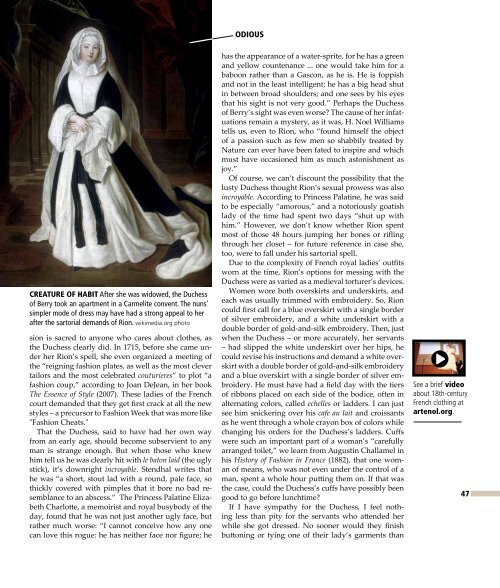artenol0416_sm_flipbook
Create successful ePaper yourself
Turn your PDF publications into a flip-book with our unique Google optimized e-Paper software.
ODIOUS<br />
CREATURE OF HABIT After she was widowed, the Duchess<br />
of Berry took an apartment in a Carmelite convent. The nuns'<br />
simpler mode of dress may have had a strong appeal to her<br />
after the sartorial demands of Rion. wikimedia.org photo<br />
sion is sacred to anyone who cares about clothes, as<br />
the Duchess clearly did. In 1715, before she came under<br />
her Rion’s spell, she even organized a meeting of<br />
the “reigning fashion plates, as well as the most clever<br />
tailors and the most celebrated couturieres” to plot “a<br />
fashion coup,” according to Joan DeJean, in her book<br />
The Essence of Style (2007). These ladies of the French<br />
court demanded that they get first crack at all the new<br />
styles – a precursor to Fashion Week that was more like<br />
"Fashion Cheats."<br />
That the Duchess, said to have had her own way<br />
from an early age, should become subservient to any<br />
man is strange enough. But when those who knew<br />
him tell us he was clearly hit with le baton laid (the ugly<br />
stick), it’s downright incroyable. Stendhal writes that<br />
he was “a short, stout lad with a round, pale face, so<br />
thickly covered with pimples that it bore no bad resemblance<br />
to an abscess.” The Princess Palatine Elizabeth<br />
Charlotte, a memoirist and royal busybody of the<br />
day, found that he was not just another ugly face, but<br />
rather much worse: “I cannot conceive how any one<br />
can love this rogue: he has neither face nor figure; he<br />
has the appearance of a water-sprite, for he has a green<br />
and yellow countenance ... one would take him for a<br />
baboon rather than a Gascon, as he is. He is foppish<br />
and not in the least intelligent; he has a big head shut<br />
in between broad shoulders; and one sees by his eyes<br />
that his sight is not very good.” Perhaps the Duchess<br />
of Berry’s sight was even worse? The cause of her infatuations<br />
remain a mystery, as it was, H. Noel Williams<br />
tells us, even to Rion, who “found himself the object<br />
of a passion such as few men so shabbily treated by<br />
Nature can ever have been fated to inspire and which<br />
must have occasioned him as much astonishment as<br />
joy.”<br />
Of course, we can’t discount the possibility that the<br />
lusty Duchess thought Rion’s sexual prowess was also<br />
incroyable. According to Princess Palatine, he was said<br />
to be especially “amorous,” and a notoriously goatish<br />
lady of the time had spent two days “shut up with<br />
him.” However, we don’t know whether Rion spent<br />
most of those 48 hours jumping her bones or rifling<br />
through her closet – for future reference in case she,<br />
too, were to fall under his sartorial spell.<br />
Due to the complexity of French royal ladies’ outfits<br />
worn at the time, Rion’s options for messing with the<br />
Duchess were as varied as a medieval torturer’s devices.<br />
Women wore both overskirts and underskirts, and<br />
each was usually trimmed with embroidery. So, Rion<br />
could first call for a blue overskirt with a single border<br />
of silver embroidery, and a white underskirt with a<br />
double border of gold-and-silk embroidery. Then, just<br />
when the Duchess – or more accurately, her servants<br />
– had slipped the white underskirt over her hips, he<br />
could revise his instructions and demand a white overskirt<br />
with a double border of gold-and-silk embroidery<br />
and a blue overskirt with a single border of silver embroidery.<br />
He must have had a field day with the tiers<br />
of ribbons placed on each side of the bodice, often in<br />
alternating colors, called echelles or ladders. I can just<br />
see him snickering over his cafe au lait and croissants<br />
as he went through a whole crayon box of colors while<br />
changing his orders for the Duchess’s ladders. Cuffs<br />
were such an important part of a woman’s “carefully<br />
arranged toilet,” we learn from Augustin Challamel in<br />
his History of Fashion in France (1882), that one woman<br />
of means, who was not even under the control of a<br />
man, spent a whole hour putting them on. If that was<br />
the case, could the Duchess’s cuffs have possibly been<br />
good to go before lunchtime?<br />
If I have sympathy for the Duchess, I feel nothing<br />
less than pity for the servants who attended her<br />
while she got dressed. No sooner would they finish<br />
buttoning or tying one of their lady’s garments than<br />
See a brief video<br />
about 18th-century<br />
French clothing at<br />
artenol.org.<br />
47

















